|
|
|
Sort Order |
|
|
|
Items / Page
|
|
|
|
|
|
|
| Srl | Item |
| 1 |
ID:
116446
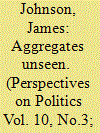

|
|
|
|
|
| Publication |
2012.
|
| Summary/Abstract |
Photography, understood as a technology for amplifying imagination, affords a useful tool for coming to terms with the massive forced migration caused by the Katrina catastrophe. Specifically, photographic projects by Robert Polidori and Richard Misrach reveal the exigencies of communicating in the wake of the disaster.
|
|
|
|
|
|
|
|
|
|
|
|
|
|
|
|
| 2 |
ID:
165361
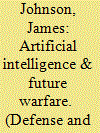

|
|
|
|
|
| Summary/Abstract |
Recent developments in artificial intelligence (AI) suggest that this emerging technology will have a deterministic and potentially transformative influence on military power, strategic competition, and world politics more broadly. After the initial surge of broad speculation in the literature related to AI this article provides some much needed specificity to the debate. It argues that left unchecked the uncertainties and vulnerabilities created by the rapid proliferation and diffusion of AI could become a major potential source of instability and great power strategic rivalry. The article identifies several AI-related innovations and technological developments that will likely have genuine consequences for military applications from a tactical battlefield perspective to the strategic level.
|
|
|
|
|
|
|
|
|
|
|
|
|
|
|
|
| 3 |
ID:
174237
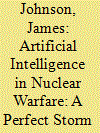

|
|
|
|
|
| Summary/Abstract |
A significant gap exists between the expectations and fears of public opinion, policymakers, and global defense communities about artificial intelligence (AI) and its actual military capabilities, particularly in the nuclear sphere. The misconceptions that exist today are largely caused by the hyperbolic depictions of AI in popular culture and science fiction, most prominently the Skynet system in The Terminator.
|
|
|
|
|
|
|
|
|
|
|
|
|
|
|
|
| 4 |
ID:
173319
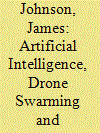

|
|
|
|
|
| Summary/Abstract |
The rapid proliferation of a new generation of artificial intelligence (AI)-augmented and -enabled autonomous weapon systems (AWS), most notably drones used in swarming tactics, could have a significant impact on deterrence, nuclear security, escalation and strategic stability in future warfare. James Johnson argues that emerging iterations of AWS fused with AI systems will presage a powerful interplay of increased range, accuracy, mass, coordination, intelligence and speed in a future conflict. In turn, the risk of escalatory use-them-or-lose-them situations between nuclear-armed military powers and the attendant dangers posed by the use of unreliable, unverified and unsafe AWS will increase, with potentially catastrophic strategic outcomes.
|
|
|
|
|
|
|
|
|
|
|
|
|
|
|
|
| 5 |
ID:
190101
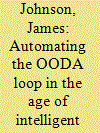

|
|
|
|
|
| Summary/Abstract |
This article argues that artificial intelligence (AI) enabled capabilities cannot effectively or reliably compliment (let alone replace) the role of humans in understanding and apprehending the strategic environment to make predictions and judgments that inform strategic decisions. Furthermore, the rapid diffusion of and growing dependency on AI technology at all levels of warfare will have strategic consequences that counterintuitively increase the importance of human involvement in these tasks. Therefore, restricting the use of AI technology to automate decision-making tasks at a tactical level will do little to contain or control the effects of this synthesis at a strategic level of warfare. The article re-visits John Boyd’s observation-orientation-decision-action metaphorical decision-making cycle (or “OODA loop”) to advance an epistemological critique of AI-enabled capabilities (especially machine learning approaches) to augment command-and-control decision-making processes. In particular, the article draws insights from Boyd’s emphasis on “orientation” as a schema to elucidate the role of human cognition (perception, emotion, and heuristics) in defense planning in a non-linear world characterized by complexity, novelty, and uncertainty. It also engages with the Clausewitzian notion of “military genius” – and its role in “mission command” – human cognition, systems, and evolution theory to consider the strategic implications of automating the OODA loop.
|
|
|
|
|
|
|
|
|
|
|
|
|
|
|
|
| 6 |
ID:
184776
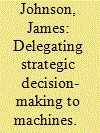

|
|
|
|
|
| Summary/Abstract |
Will the use of artificial intelligence (AI) in strategic decision-making be stabilizing or destabilizing? What are the risks and trade-offs of pre-delegating military force to machines? How might non-nuclear state and non-state actors leverage AI to put pressure on nuclear states? This article analyzes the impact of strategic stability of the use of AI in the strategic decision-making process, in particular, the risks and trade-offs of pre-delegating military force (or automating escalation) to machines. It argues that AI-enabled decision support tools - by substituting the role of human critical thinking, empathy, creativity, and intuition in the strategic decision-making process - will be fundamentally destabilizing if defense planners come to view AI’s ‘support’ function as a panacea for the cognitive fallibilities of human analysis and decision-making. The article also considers the nefarious use of AIenhanced fake news, deepfakes, bots, and other forms of social media by non-state actors and state proxy actors, which might cause states to exaggerate a threat from ambiguous or manipulated information, increasing instability.
|
|
|
|
|
|
|
|
|
|
|
|
|
|
|
|
| 7 |
ID:
177041
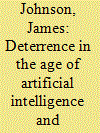

|
|
|
|
|
| Summary/Abstract |
How might nuclear deterrence be affected by the proliferation of artificial intelligence (AI) and autonomous systems? How might the introduction of intelligent machines affect human-to-human (and human-to-machine) deterrence? Are existing theories of deterrence still applicable in the age of AI and autonomy? The article builds on the rich body of work on nuclear deterrence theory and practice and highlights some of the variegated and contradictory – especially human cognitive psychological – effects of AI and autonomy for nuclear deterrence. It argues that existing theories of deterrence are not applicable in the age of AI and autonomy and introducing intelligent machines into the nuclear enterprise will affect nuclear deterrence in unexpected ways with fundamentally destabilising outcomes. The article speaks to a growing consensus calling for conceptual innovation and novel approaches to nuclear deterrence, building on nascent post-classical deterrence theorising that considers the implications of introducing non-human agents into human strategic interactions.
|
|
|
|
|
|
|
|
|
|
|
|
|
|
|
|
| 8 |
ID:
178737
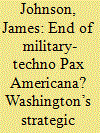

|
|
|
|
|
| Summary/Abstract |
This article uses the international relations (IR) ‘polarity’ concept as a lens to view the shifting great power dynamics in artificial intelligence (AI) and related enabling technologies. The article describes how and why great power competition is mounting in within several interrelated dual-use technological fields; why these innovations are considered by Washington to be strategically vital, and how (and to what end) the United States is responding to the perceived challenge posed by China to its technological hegemony. The following questions addressed in this paper fill a gap in the existing literature: Will the increasingly competitive U.S.-China relationship dominate world politics creating a new bipolar world order, as opposed to a multipolar one? Why does the U.S. view China’s progress in dual-use AI as a threat to its first-mover advantage? How might the U.S. respond to this perceived threat?
|
|
|
|
|
|
|
|
|
|
|
|
|
|
|
|
| 9 |
ID:
185828


|
|
|
|
|
| Summary/Abstract |
Will AI-enabled capabilities increase inadvertent escalation risk? This article revisits Cold War-era thinking about inadvertent escalation to consider how Artificial Intelligence (AI) technology (especially AI augmentation of advanced conventional weapons) through various mechanisms and pathways could affect inadvertent escalation risk between nuclear-armed adversaries during a conventional crisis or conflict. How might AI be incorporated into nuclear and conventional operations in ways that affect escalation risk? It unpacks the psychological and cognitive features of escalation theorising (the security dilemma, the ‘fog of war’, and military doctrine and strategy) to examine whether and how the characteristics of AI technology, against the backdrop of a broader political-societal dynamic of the digital information ecosystem, might increase inadvertent escalation risk. Are existing notions of inadvertent escalation still relevant in the digital age? The article speaks to the broader scholarship in International Relations – notably ‘bargaining theories of war’ – that argues that the impact of technology on the cause of war occurs through its political effects, rather than tactical or operational battlefield alterations. In this way, it addresses a gap in the literature about the strategic and theoretical implications of the AI-nuclear dilemma.
|
|
|
|
|
|
|
|
|
|
|
|
|
|
|
|
| 10 |
ID:
181547
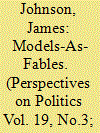

|
|
|
|
|
| Summary/Abstract |
Political scientists invoke the standard rationale to justify making and using formal models. It goes like this: (1) we rely on formal models to generate predictions, (2) we treat these predictions as empirical hypotheses, and (3) we seek to test these hypotheses against evidence derived from the “real world.” I show that this interpretation of formal models as directly empirical is inadequate just insofar as it fails to capture the way we actually use them. I then offer an alternative rationale for making and using formal models. Specifically, I argue that we use models, like we use fables, for conceptual purposes.
|
|
|
|
|
|
|
|
|
|
|
|
|
|
|
|
| 11 |
ID:
152090
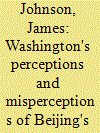

|
|
|
|
|
| Summary/Abstract |
Washington has become increasingly concerned that Beijing's anti-access area-denial (A2-AD) capabilities will put at risk US military assets and forward forces operating in the Western Pacific region, enabling China to deter, delay and deny US intervention in future regional conflict and crisis. US defence analysts in their assessments have frequently, and often erroneously, conflated a Chinese operational capability with an underlying strategic intention that conceptualises the United States as its primary (if not sole) target. The central argument this article proffers is that US perceptions of A2-AD have been framed by specific analytical baselines that have overlooked the evolution of Chinese operational and doctrinal preferences, and over-reliant upon military material-based assessments to determine Beijing's strategic intentions, and formulate US military countervails. The article concludes that the strategic ambiguities and opacity associated with Chinese A2-AD capabilities and its ‘active defence’ concept reinforced Washington's reliance upon capacity-based assessments that in turn, exacerbated misperceptions confounded by cognitive bias of Chinese strategic intentions. The critical framing assumptions of this article draw heavily upon the ideas and rationale associated with the international relations ‘Security Dilemma’ concept.
|
|
|
|
|
|
|
|
|
|
|
|
|
|
|
|
|
|
|
|
|